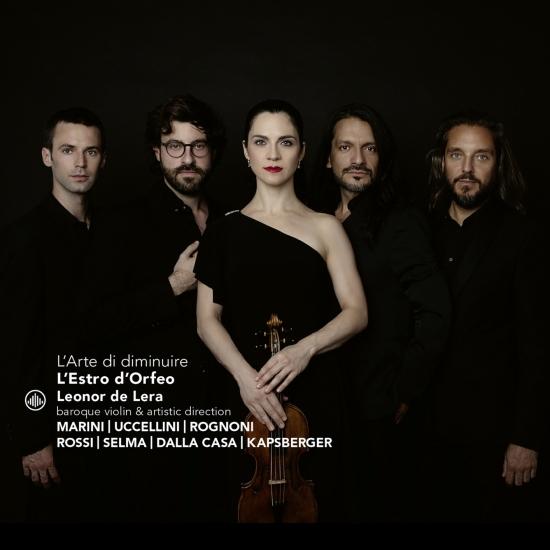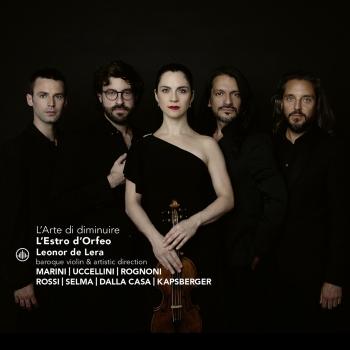
L'arte Di Diminuire L'Estro d'Orfeo & Leonor de Lera
Album info
Album-Release:
2020
HRA-Release:
06.03.2020
Label: Challenge Classics
Genre: Classical
Subgenre: Chamber Music
Artist: L'Estro d'Orfeo & Leonor de Lera
Album including Album cover
- Leonor de Lera:
- 1Descendi in hortum meum di Palestrina passeggiato04:02
- Francesco Rognoni:
- 2Vestiva i colli. Modo difficile per suonar alla bastarda04:36
- Biagio Marini (1597-1665):
- 3Romanesca per violino solo e basso se piace04:51
- Leonor de Lera:
- 4Pulchra es amica mea di Palestrina05:09
- 5Diminuzioni sopra “Usurpator tiranno“ di Giovanni Felice Sances06:42
- Marco Uccellini (1610-1680):
- 6Aria decima quarta a doi violini sopra “La mia pedrina”04:11
- Girolamo Dalla Casa:
- 7Petit Jacquet da sonar con la Viola Bastarda04:31
- Giovanni Kapsberger (1580 - 1651):
- 8Folia07:16
- 9Aria quinta sopra “La Bergamasca”04:24
- Rodney Prada:
- 10Io canterei d‘amor di Cipriano per suonar alla bastarda03:51
- Javier Nunez:
- 11O felici occhi miei di Arcadelt05:05
- Bartolome Salaverde (1580 - 1640)
- 12Vestiva i colli passeggiato a doi. Basso e soprano03:43
- Salomone Rossi (1570 - 1930):
- 13Sonata quinta sopra un’Aria francese02:36
- Girolamo Dalla Casa:
- 14Petite fleur coincte03:18
- Leonor de Lera:
- 15Tarantella del Gargano diminuita04:49
Info for L'arte Di Diminuire
Diminutions, the art of extemporary embellishment or melodic variation, were an essential part of performance practice of the Renaissance and early Baroque periods. The basis of diminutions is the fragmentation of a long note or series of long notes into many shorter and faster ones that move around the original melody. In the 16th and early 17th centuries, a composition as written by the composer was often regarded as raw material and it was normal and even required of musicians to embellish the works performed. The number of treatises that were devoted to the teaching of this subject is a clear indication of the importance of diminutions at that time. Most of these manuals included a collection of decorated melodies taken from renowned madrigals, motets and chansons by well-known composers of the time. These pieces give us clear examples of how music was performed during that time and what was considered the proper way to embellish a piece of music. Often technically demanding, these pieces gave scope for virtuoso display as they required great dexterity from the performer. In conclusion, diminutions were added to make a piece of music more ‘beautiful’.
This album explores the widespread practice of diminutions by presenting published examples of diminutions on well-known motets, by master composers; diminutions on popular melodies or dance forms and finally, diminutions composed by the performer as artist. I hope this recording will bring the listeners closer to the subject of diminutions which is, in my opinion, an art in itself.
L’Estro d’Orfeo:
Leonor de Lera, baroque violin
Josué Meléndez, cornett, recorder
Rodney Prada, viola da gamba
Josep Maria Marti, theorbe, baroque guitar
Javier Núnez, harpsichord, organ

L'Estro d'Orfeo & Leonor de Lera
Founded by Leonor de Lera, El Canto de Orfeo is an ensemble that specializes in instrumental music of the seventeenth century, making use of period instruments and with a historically informed approach in line with the aesthetics of the time.
It takes its name and inspiration from the greek legend of Orpheus. Son of the god Apollo, god of the music and the arts; and Calliope, the muse of poetry and eloquence; Orpheus inherited from them the gift of music and poetry. As Apollo was considered the best musician amongst the gods, so was Orpheus considered the best musician amongst the mortals.
By dint of his music and singing, he could charm all living things and even rocks. He had the ability to appease and coax the wild beasts; the birds, moved by the sound of his music, would fall under a spell and stop flying; the trees would unearth their roots to move closer and crowd around him and the rivers would arrest their course to listen to his singing. There was not a god or mortal that could withstand his strains.
Taking Orpheus as its inspiration and following the ideals of the baroque period, the ensemble El Canto de Orfeo has as its purpose inviting its audience to take a journey through the wide variety of emotions that music presents to us.
Its members, all of them with an extensive training and profesional experience in the early music field, and with origins that span both sides of the Atlantic Ocean, share one common goal: to bring to life and to spread the musical repertoire of one of the most fascinating periods of our history.
This album contains no booklet.










